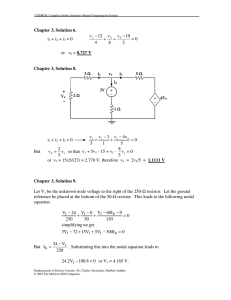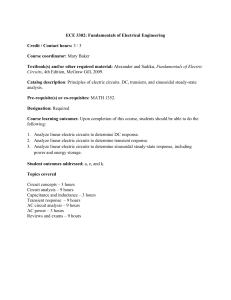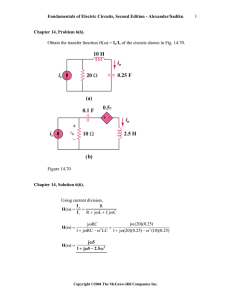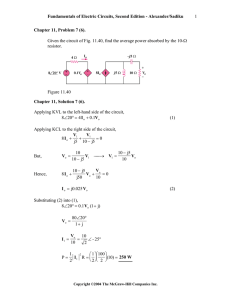Fundamentals of Electric Circuits, Second Edition
advertisement
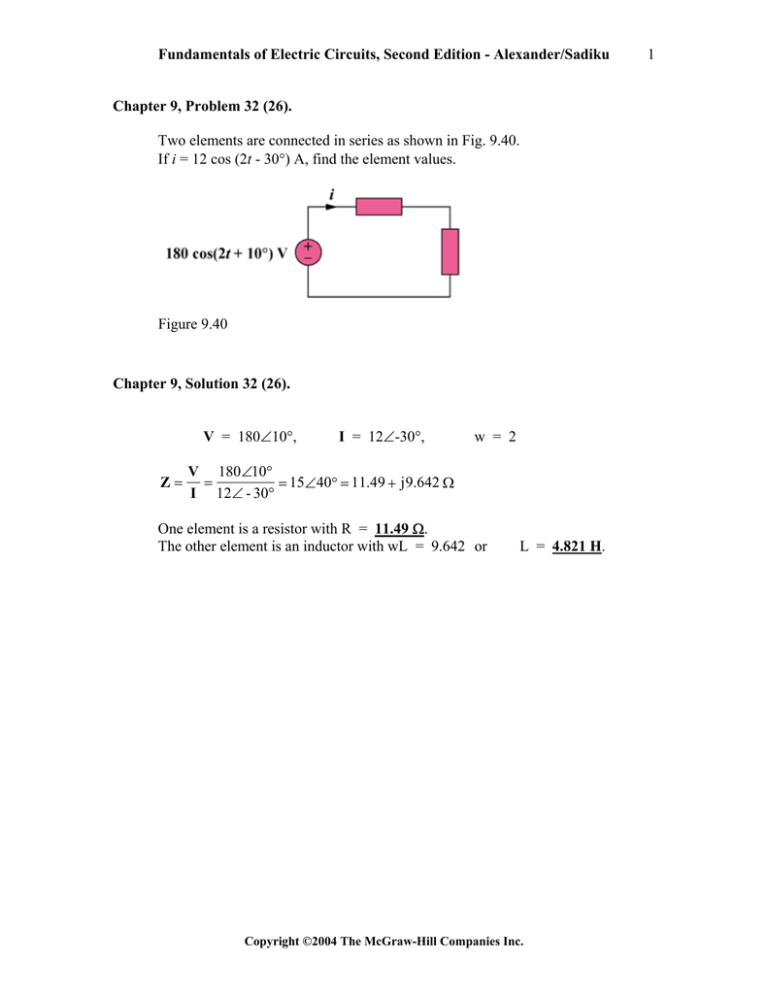
Fundamentals of Electric Circuits, Second Edition - Alexander/Sadiku Chapter 9, Problem 32 (26). Two elements are connected in series as shown in Fig. 9.40. If i = 12 cos (2t - 30°) A, find the element values. Figure 9.40 Chapter 9, Solution 32 (26). V = 180∠10°, Z= I = 12∠-30°, w = 2 V 180∠10° = = 15∠40° = 11.49 + j 9.642 Ω I 12∠ - 30° One element is a resistor with R = 11.49 Ω. The other element is an inductor with wL = 9.642 or L = 4.821 H. Copyright ©2004 The McGraw-Hill Companies Inc. 1 Fundamentals of Electric Circuits, Second Edition - Alexander/Sadiku Chapter 9, Problem 46 (39). If is = 5 cos (10t + 40°) A in the circuit in Fig. 9.53, find io. Figure 9.53 Chapter 9, Solution 46 (39). i s = 5 cos(10 t + 40°) → I s = 5∠40° Let 0.1 F → 1 1 = = -j jωC j (10)(0.1) 0.2 H → jωL = j (10)(0.2) = j2 Z1 = 4 || j2 = j8 = 0.8 + j1.6 , 4 + j2 Z2 = 3 − j Io = Z1 0.8 + j1.6 (5∠40°) Is = 3.8 + j0.6 Z1 + Z 2 Io = (1.789∠63.43°)(5∠40°) = 2.325∠94.46° 3.847 ∠8.97° Thus, i o ( t ) = 2.325 cos(10t + 94.46°) A Copyright ©2004 The McGraw-Hill Companies Inc. 2 Fundamentals of Electric Circuits, Second Edition - Alexander/Sadiku Chapter 9, Problem 55 (44). Find Z in the network of Fig. 9.62, given that Vo = 4∠0° V Figure 9.62 Chapter 9, Solution 55 (44). 12 Ω -j20 V I I1 Z I2 + − -j4 Ω + Vo j8 Ω − I1 = Vo 4 = = -j0.5 j 8 j8 I2 = I 1 (Z + j8) (-j0.5)(Z + j8) Z = = +j - j4 - j4 8 I = I 1 + I 2 = -j0.5 + Z Z + j = + j0.5 8 8 - j20 = 12 I + I 1 (Z + j8) Z j - j - j20 = 12 + + (Z + j8) 8 2 2 3 1 - 4 - j26 = Z − j 2 2 Z = 2.798 – j16.403 Ω Z= - 4 - j26 26.31∠261.25° = = 16.64∠279.68° 3 1 1.5811∠ - 18.43° −j 2 2 Copyright ©2004 The McGraw-Hill Companies Inc. 3 Fundamentals of Electric Circuits, Second Edition - Alexander/Sadiku Chapter 9, Problem 66 (50). For the circuit in Fig. 9.73, calculate ZT and Vab. Z T = (20 − j5) || (40 + j10) = (20 − j5)(40 + j10) 170 = (12 − j) 60 + j5 145 Z T = 14.069 – j1.172 Ω = 14.118∠-4.76° I= 60∠90° V = = 4.25∠94.76° Z T 14.118∠ - 4.76° I I1 I2 20 Ω j10 Ω + Vab I1 = 40 + j10 8 + j2 I= I 60 + j5 12 + j I2 = 20 − j5 4− j I= I 60 + j5 12 + j Vab = -20 I 1 + j10 I 2 - 150 (-12 + j)(150) I= I 12 + j 145 Vab = 52.94∠273° V Vab = Vab = - (160 + j40) 10 + j40 I+ I 12 + j 12 + j Vab = (12.457 ∠175.24°)(4.25∠97.76°) Copyright ©2004 The McGraw-Hill Companies Inc. 4 Fundamentals of Electric Circuits, Second Edition - Alexander/Sadiku Chapter 9, Problem 79 (61). (a) Calculate the phase shift of the circuit in Fig. 9.82. (b) State whether the phase shift is leading or lagging (output with respect to input). (c) Determine the magnitude of the output when the input is 120 V. Figure 9.82 Chapter 9, Solution 79 (61). Consider the circuit as shown. 20 Ω V2 40 Ω V1 30 Ω + Vi + j10 Ω j30 Ω − j60 Ω Vo − Z2 Z1 ( j30)(30 + j60) = 3 + j21 30 + j90 ( j10)(43 + j21) Z 2 = j10 || (40 + Z1 ) = = 1.535 + j8.896 = 9.028∠80.21° 43 + j31 Z1 = j30 || (30 + j60) = Let Vi = 1∠0° . Z2 (9.028∠80.21°)(1∠0°) Vi = Z 2 + 20 21.535 + j8.896 V2 = 0.3875∠57.77° V2 = Copyright ©2004 The McGraw-Hill Companies Inc. 5 Fundamentals of Electric Circuits, Second Edition - Alexander/Sadiku Z1 3 + j21 (21.213∠81.87°)(0.3875∠57.77°) V2 = V2 = 43 + j21 47.85∠26.03° Z1 + 40 V1 = 0.1718∠113.61° V1 = j60 j2 2 V1 = V1 = (2 + j)V1 30 + j60 1 + j2 5 Vo = (0.8944∠26.56°)(0.1718∠113.6°) Vo = 0.1536 ∠140.2° Vo = Therefore, the phase shift is 140.2° The phase shift is leading. If Vi = 120 V , then Vo = (120)(0.1536∠140.2°) = 18.43∠140.2° V and the magnitude is 18.43 V. Copyright ©2004 The McGraw-Hill Companies Inc. 6 Fundamentals of Electric Circuits, Second Edition - Alexander/Sadiku 7 Chapter 9, Problem 84 (66). The ac bridge shown in Fig. 9.84 is known as a Maxwell bridge and is used for accurate measurement of inductance and resistance of a coil in terms of a standard capacitance Cs. Show that when the bridge is balanced, Lx = R2 R3 Cs and Rx = R2 R3 R1 Find Lx and Rx for R1 = 40 kΩ, R2 = 1.6 kΩ, R3 = 4 kΩ, and Cs = 0.45 µF. Figure 9.84 Chapter 9, Solution 84 (66). Let 1 Z2 = R 2 , , jωC s R1 jωC s R1 Z1 = = 1 jωR 1C s + 1 R1 + jωC s Z1 = R 1 || Since Z x = Z 3 = R 3 , and Z x = R x + jωL x . Z3 Z , Z1 2 R x + jωL x = R 2 R 3 jωR 1C s + 1 R 2 R 3 = (1 + jωR 1C s ) R1 R1 Equating the real and imaginary components, Copyright ©2004 The McGraw-Hill Companies Inc. Fundamentals of Electric Circuits, Second Edition - Alexander/Sadiku Rx = ωL x = R 2R 3 R1 R 2R 3 (ωR 1C s ) implies that R1 L x = R 2 R 3Cs Given that R 1 = 40 kΩ , R 2 = 1.6 kΩ , R 3 = 4 kΩ , and C s = 0.45 µF R 2 R 3 (1.6)(4) = kΩ = 0.16 kΩ = 160 Ω R1 40 L x = R 2 R 3 C s = (1.6)(4)(0.45) = 2.88 H Rx = Copyright ©2004 The McGraw-Hill Companies Inc. 8 Fundamentals of Electric Circuits, Second Edition - Alexander/Sadiku Chapter 9, Problem 90 (72). An industrial coil is modeled as a series combination of an inductance L and resistance R, as shown in Fig. 9.90. Since an ac voltmeter measures only the magnitude of a sinusoid, the following measurements are taken at 60 Hz when the circuit operates in the steady state: Vs = 145V, V1 = 50V, Vo = 110V Use these measurements to determine the values of L and R. Figure 9.90 Chapter 9, Solution 90 (72). Let Vs = 145∠0° , X = jωL = j (2π )(60) L = j377 L Vs 145∠0° I= = 80 + R + jX 80 + R + jX V1 = 80 I = 50 = (80)(145) 80 + R + jX (80)(145) 80 + R + jX (1) Vo = (R + jX) I = (R + jX)(145∠0°) 80 + R + jX Copyright ©2004 The McGraw-Hill Companies Inc. 9 Fundamentals of Electric Circuits, Second Edition - Alexander/Sadiku 110 = (R + jX)(145) 80 + R + jX (2) From (1) and (2), 50 80 = 110 R + jX 11 R + jX = (80) 5 R 2 + X 2 = 30976 (3) From (1), (80)(145) = 232 50 6400 + 160R + R 2 + X 2 = 53824 160R + R 2 + X 2 = 47424 80 + R + jX = (4) Subtracting (3) from (4), 160R = 16448 → R = 102.8 Ω From (3), X 2 = 30976 − 10568 = 20408 X = 142.86 = 377 L → L = 0.3789 H Copyright ©2004 The McGraw-Hill Companies Inc. 10

